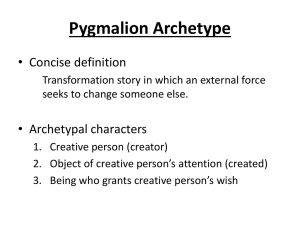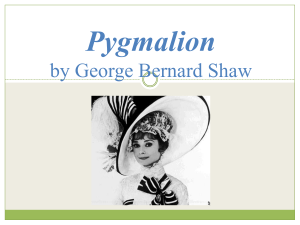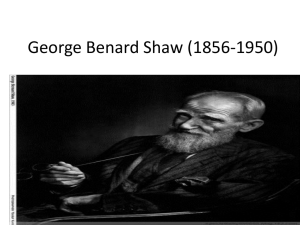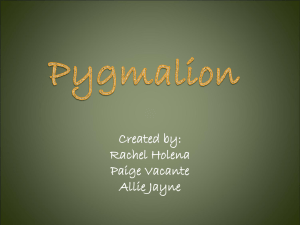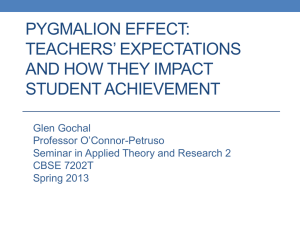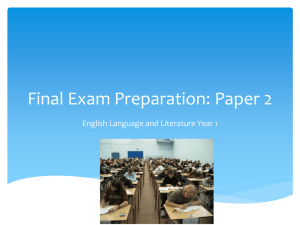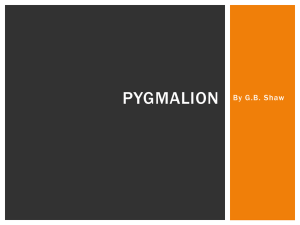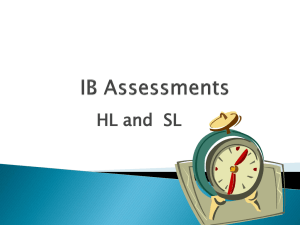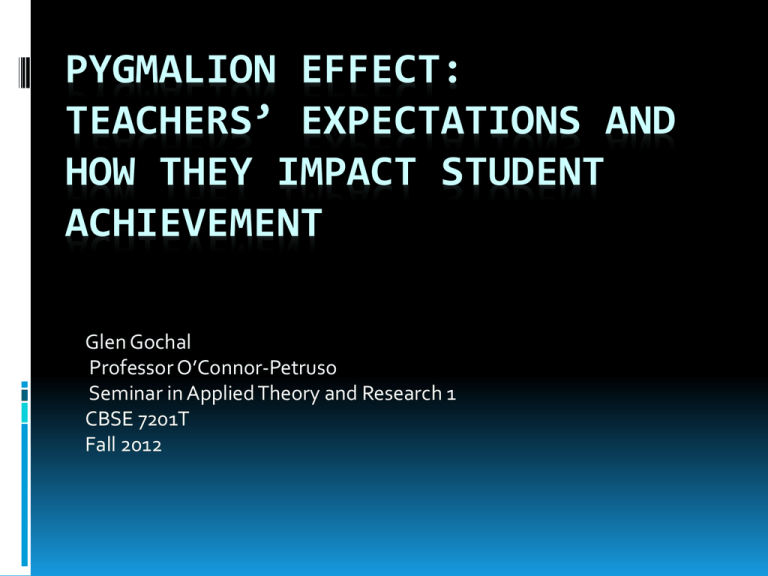
PYGMALION EFFECT:
TEACHERS’ EXPECTATIONS AND
HOW THEY IMPACT STUDENT
ACHIEVEMENT
Glen Gochal
Professor O’Connor-Petruso
Seminar in Applied Theory and Research 1
CBSE 7201T
Fall 2012
Table of Contents
Abstract
Introduction: Slide 3
Statement of Problem: Slide 4
Review of Related Literature: Slides 5-19
Statement of Hypothesis: Slide 20
Method: Slide 21
Participants: Slide 21
Instruments: Slide 21
Experimental Design
Procedure
Results
Discussion
Implications
References Slides 22-25
Appendices: Slides 26-30
The Pygmalion Effect in Education
Introduction:
Most teachers know a little bit about the Pygmalion effect, or
the idea that one's expectations about a person can
eventually lead that person to behave and achieve in ways
that confirm those expectations.
How many of you think that you are reasonably good judges
of character? With years of teaching experience under your
belt, are you more often than not able to size up students
correctly? Occasionally you are wrong, but most often you
are correct. Right? Many teachers believe that they can judge
ahead of time, sometimes by just a glance the first day of
school, how certain students are likely, over time, to achieve
and behave.
Statement of Problem:
When adapted to the field of education, the
Pygmalion effect has far reaching ramifications
on the effectiveness of today’s teaching approach
and execution. It is essential that educators
become distinctly aware of just how much effect
their assumptions on a student’s performance can
have on that student’s abilities. This is
particularly critical when those assumptions have
negative connotations. When an educator
anticipates that a student will perform poorly, the
student will inevitably perform according to those
expectations.
REVIEW OF
RELATED
LITERATURE
Intervention Topics
Avoid unreliable sources of information about students' learning potential, e.g.,
social stereotypes, the biases of other teachers, etc.
Set goals (for individuals, groups, classrooms, and whole schools) in terms of floors
(minimally acceptable standards), not ceilings; communicate to students that they
have the ability to meet those standards.
Emphasize that different students are good at different things and let students see
that this is true by having them observe one another's products, performances, etc.
Concentrate on extending warmth, friendliness, and encouragement to all students.
Monitor student progress closely so as to keep expectations of individuals current.
In giving students feedback, stress continuous progress relative to previous levels of
mastery, rather than comparisons with statistical norms or other individuals.
In giving students feedback, focus on giving useful information, not just evaluation
of success or failure.
In general, think in terms of stretching the students' minds by stimulating them and
encouraging them to achieve as much as they can, not in terms of "protecting" them
from failure or embarrassment.
(Cotton 1989)
The Pygmalion Effect works through the
self-fulfilling prophecy.
..."You see, really and truly, apart from the things anyone
can pick up (the dressing and the proper way of speaking,
and so on), the difference between a lady and a flower girl
is not how she behaves, but how she's treated. I shall
always be a flower girl to Professor Higgins, because he
always treats me as a flower girl, and always will; but I
know I can be a lady to you, because you always treat me
as a lady, and always will.”
George Bernard Shaw - Pygmalion
Pygmalion Effect, fact or fiction?
“Strong empirical support was found for a
reciprocal relationship between teachers’
behavior and students’ engagement. Teachers’
interactions with students predicted students’
behavioral and emotional engagement in the
classroom, both directly and through their
effects on student’s perceptions of their
interactions with teachers.”
(Skinner, Ellen A., Belmont, Michael J.1993).
Four Factors in Mediation of Teacher
Expectancy Effects
Central factors:
Climate (affect): Teachers appear to create a warmer socio-emotional climate for their
“special” students. This warmth appears to be at least partially communicated by
nonverbal cues.
Input (effort): Teachers appear to teach more material and more difficult material to their
“special” students.
Additional factors:
Output : Teachers appear to give their “special” students greater opportunities for
responding. These opportunities are offered both verbally and nonverbally (e.g. giving
a student more time in which to answer).
Feedback : Teachers appear to give their “special” students more informative feedback,
both verbal and nonverbal, as to how these students have been performing.
(Rosenthal 1994)
What can be done to help teachers be
aware of and combat the Pygmalion
Effect?
Efforts aimed at helping teachers to avoid
harmful stereotyping of students often begin
with activities designed to raise teachers'
awareness of their unconscious biases.
(Cotton. 1989)
Independent Evaluation
SETTING GOALS WHICH ARE EXPRESSED
AS MINIMALLY ACCEPTABLE LEVELS OF
ACHIEVEMENT rather than using prior
achievement data to establish ceiling levels
beyond which students would not be
expected to progress (Good, 1987)
Cycle of Expectations
The self-fulfilling model posits that sales
managers’ expectations and treatment of
salespersons will be influenced by background
factors of the salespersons (e.g., age gender,
ethnicity, experience). These expectations and
treatment by the sales manager will, in turn,
influence the salespersons’ self-expectations,
which will ultimately influence the performance
of the salespersons.
(Chowdhury, 2007)
Defiance of Expectations
I ask them to define a research problem,
search the literature, design an experiment
and come in with results all in one semester.
Now nobody can do all that in one semester. I
can't do that in one semester, but these are
juniors: they don't know it can't be done; so
they all do it. They do amazing things (Rhem,
1999).
Teacher Dependence
They see teaching as a technical activity of
“transmitting” the certified content of the school
curriculum from books to students. Similarly,
they see learning to teach as the simple act of
acquiring technical knowledge and skills that will
allow teachers to dispense information to
students efficiently—which involves providing
different types of educational experiences to
students of different abilities.
(Villegas, 2007)
Great Expectations Yield Great Results
They concluded that students whose teachers
expected a high increase of learning ability within
the next year, indeed had higher intelligence scores
at the end of the school year.
(Jussim, L. & Harber, K.2005)
Students' early performance and gender predicted
teachers' expectations, with higher expectations for
high achieving students and girls.
(Madon, S. & Jussim, L. 1998)
Low Expectations Yield Poor Results
“ compared to their treatment of low expectation
students, teachers were more likely to praise high
expectation students for correct answers, less likely
to criticize them for failure, and more likely to try to
elicit an improved response from them when they
failed to answer correctly the first time.”
(Brophy, 1974)
Low achieving students tend to receive more
criticism and less praise from professional teachers.
Teachers tend to praise high expectation students
more.
(Copper, 1979
Teachers as Divisive Forces
Taken together, the findings in this study suggest that teachers play a
role in enlarging existing socio-economic background differences
between children, with differential effects for majority and minority
children.
(Speybroeck,S. & Damme,J.,2012)
The evidence presented here suggests that teachers base their
expectations upon past performance to a much greater degree than
upon ethnicity, sex, socioeconomic status, or intellectual ability.
(Clifton, 1981)
Teachers as Agents of Stagnation
"How should mature-age student-teachers respond to
expectations that are in most cases groundless?" Here
things don't look too good. Rosenthal (1968/1992) showed
that when pupils improve against expectations they are
disliked by their teachers and in some cases show signs of
being in conflict.
(Rosenthal, R., & Jacobson,l 1968)
If teachers are able to recognize their own nonverbal
behaviors, they can determine if the behaviors are
appropriate to the goals of the task and occur enough to
become reliable cues to the students.
(Woolfolk,A.E, & Brooks,D.M.,1985)
Organizational Control
The implication here is that organizations have a
responsibility to shape behavior by creating
expectant environments that induce positive
behavior. Of course, we are really talking about
people when we speak of such abstract things
such as "organizations" and "environments."
Organizations are made up of people and when
we speak of creating expectant environments we
are speaking about developing teachers who
have high expectations of their students.
(Etheriggton , 2011)
Statement of Hypothesis
Hypothesis 1:
When teachers express an opinion towards a student’s academic performance,
that opinion tends to become reality. A survey of 3 second grade teachers in the
below cited public school will ask them the importance of information being
passed on between teachers year to year.
Hypothesis 2:
Presented with an anticipation of what his academic performance will be
by a teacher, a student will perform accordingly. A group of 60 second
grade students in an urban public school will be surveyed to ascertain their
opinions of what , if any, feelings their teacher has verbally or nonverbally
expressed about them.
Intervention:
Seminar for teachers at the beginning of the school year on the importance
of relaying only factual information on students to other teachers, being
careful to keep subjective opinions on capability and performance to
themselves.
Method
Participants:
A group of 60 second grade students in an
urban public school will be surveyed. A survey
of 3 second grade teachers in the same public
school.
Instruments:
Both sets of participants in this study will be
surveyed to ascertain if the Pygmalion effect
was active in these groups.
References
Bellamy, G. (1975). The Pygmalion effect: What teacher behaviors mediate it? Psychology in the Schools, l12 (4), 454-460,
Brophy, J.E. (1983). Research on the self-fulfilling prophecy and teacher expectations. Journal of Educational Psychology 75,
631-661.
Brohpy, J.E., Good, T.L. (1974). Teacher-Student Relationships: Causes and Consequences. New York, NY: Holt, Rinehard, and
Winston
Cecil, N. (1988). Black dialect and academic success: A study of teacher expectations. Reading Improvement, 25 (1), 34-38.
Chowdhury, M. (2007). Pygmalion in sales: The influence of supervisor expectancies on salesperson’s self-expectations and
work evaluations. Journal of Business and Public Affairs, 1 (1).
Clifton,R.A. (1981). Ethnicity, teacher expectations, and the academic achievement process in Canada. Sociology of Education
54, 291-301.
Cooper, H. (1979). Pygmalion grows up: A model for teacher expectation communication and performance influence. Review of
Educational Research, 49 (3), 389-410.
Cotton, K. (1989). Expectations and student outcomes. School Improvement Research Series. Office of Educational Research
and Improvement (OERI), U.S. Department of Education. Washington, DC: U.S. Government Printing Office.
Crohn,L. (1983). Toward Excellence: Student and Teacher Behaviors as Predictors of School Success. Research Summary report.
Northwest Regional Educational Laboratory. Portland, OR. (Ed 242-704)
References (2)
Dusek, J., & O'Connell, E.J. (1973). Teacher expectancy effects on the achievement test performance of elementary school
children. Journal of Educational Psychology, 65 (3), 371-377.
Etheriggton, M. (2011). The Pygmalion principle: The practicum expectations and experiences of mature aged student teachers.
Issues in Educational Research, 21(3), 259-280.
Farley, J.R. (1982). Raising student achievement through the affective domain. Educational Leadership, 39 (7), 502-505.
Feldman, R., & Prohaska, T. (1979). The Student as Pygmalion: Effect of student expectation on the teacher. Journal of
Educational Psychology, 71 (4), 485-493
Findley,M. , & Good,T. (1982). Relations between student achievement and various indexes of teacher expectations. Journal of
Educational Psychology, 74, 577-590.
Good, T.L. (1987). Two Decades of research on teacher expectations: Findings and future directions. Journal of Teacher Education,
38, 32-47.
Jussim, L., & Harber, K. (2005). Teacher expectations and self-fulfilling prophecies: Knowns and unknowns, resolved and
unresolved controversies. Personality & Social Psychology Review (Lawrence Erlbaum Associates), 9 (2), 131-155.
Karcher, M., Davidson, A., Rhodes, J., & Herrera, Carla. (2010). Pygmalion in the Program: The Role of teenage peer mentors'
attitudes in shaping their mentees' outcomes. Applied Developmental Science, 14 (4), 212-227.
Madon, S., & Jussim, L. (1997). In Search of the powerful self-fulfilling prophecy. Journal of Personality & Social Psychology,
72(4), 791-809.
References (3)
Natanovich, G., & Eden, D. (2008). Pygmalion effects among outreach supervisors and tutors: Extending sex generalizability. Journal
of Applied Psychology, 93(6), 1382-1389, doi: 10.1037/a0012566.
Patriarca, L.A., & Kragt, D. M. (1986). Teacher expectations and student achievement: The Ghost of Christmas Future. Curriculum
Review, 25(5), 48-50.
Rhem,J. (1999). Pygmalion in the Classroom. National Teaching and Learning Forum. 8 (2), 1-4.
Rosenthal, R. (1987). “Pygmalion” Effects: existence, magnitude, and social importance. Educational Researcher, 16 (9), 37-41.
Rosenthal, R. (1994). Interpersonal expectancy effects: A 30-Year perspective. Current Directions in Psychological Science, 3 (6), 176179.
Rosenthal, R., & Jacobson L. (1968). Pygmalion in the classroom: teacher expectation and pupils’ intellectual development. New
York: Holt, Rinehart & Winston,
Saphier, J., & Gower, R. The Skillful Teacher: Building your teaching skills (5th ed. pp 293-342) Carlise, Ma.
Skinner, Ellen A.,& Belmont, Michael J. (1993). Motivation in the Classroom: Reciprocal effects of teacher behavior and student
engagement across the school year. Journal of Educational Psychology 85 (4), 571-581.
Smith, A.E., & Jussim, L. (1998). Self-fulfilling prophecies, perceptual biases, and accuracy at the individual and group levels. Journal
of Experimental Social Psychology, 34 (6), 530-561.
References (4)
Speybroeck,S., & Damme,J.(2012). The role of teachers' expectations in the association between children's SES and
performance in kindergarten: A Moderated Mediation Analysis. PLoS One 7 (n4), Published online 2012 April 10.
Villegas,A.M. (2007). Dispositions in teacher education: A look at social justice. Journal of Teacher Education,58 (5), 370-380.
Winfield, L.F. (1986). Teacher beliefs toward academically at risk students in inner urban schools. Urban Review,18 (4),
253-68
Woolfolk, A.E., & Brooks, D. M. (1985). The Influence of teachers' nonverbal behaviors on students' perceptions and
performance. Elementary School Journal, 85(4), 513-528.
Appendix A:
Student Survey
Appendix B:
Teacher Survey
Appendix C:
Parent Permission
Dear Parent/Guardian,
I am currently a graduate student in Brooklyn College’s Childhood Education Master’s program. I am
conducting a research study on the effects of teacher expectations of students and their subsequent academic
performance. This phenomenon is called the Pygmalion effect in education.
I would like to request your permission to allow your child to fill out a survey on his/her feelings towards
his/her current teacher and about the relationship with this teacher. The survey to be used will not ask for any
information about the specific identity of your child, such as his/her name or gender, and the data collected will be
used for my research study only. The goal of the study is to increase the academic integrity of the public schools.
All results for this study will be reported as a group study and the participants’ names and information will
be anonymous. I greatly appreciate your support. If you have any questions please feel free to contact me.
gleng2041@aol.com or at 917-945-7485
Sincerely,
Glen Gochal
I give my child__________________________________________ permission to be a participant in this research
study.
Parent’s Signature:___________________________________ Date:____________________
Appendix D: Teacher’s Permission
Dear _____________________,
I am currently a graduate student in Brooklyn College’s Childhood Education Master’s
program. I am conducting a research study on the Pygmalion effect in the educational process. I
am requesting your permission to use information gathered from your students for my research
study. Students would be answering a survey without revealing their names, or any other
identifying characteristics such as gender or address.
All results for this study will be reported as a group study and the participants’ names and
information will be anonymous. I greatly appreciate your support. If you have any questions
please feel free to contact me. Gleng2041@aol.com or at 9147-945-7485
Sincerely,
Glen Gochal
I, __________________________________________ give my permission to be a participant in this
research study.
Teacher’s Signature:___________________________________ Date:____________________
Appendix E:
Principal’s Permission
Dear Principal_____________________,
I am currently a graduate student in Brooklyn College’s Childhood Education Master’s
program and am conducting a research study on Pygmalion effect on the educational process. I
am requesting your permission to use select second grade students from your school to fill out a
survey. The survey would ask each child about his/her feelings towards his/her current teacher and
about the relationship with this teacher. There will be no identifying information requested in this
survey, such as name or gender.
All results for this study will be reported as a group study and therefore, the participants’
names and information will be anonymous. I greatly appreciate your support. If you have any
questions please feel free to contact me. Gleng2041@aol.com or at 9147-945-7485
Sincerely,
Glen Gochal
I, __________________________________________ give my permission to be a participant in this
research study.
Principal’s Signature:___________________________________ Date:____________________

